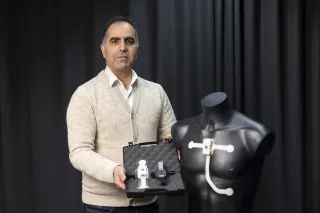Close scrutiny of basic vital functions supports a patient's care and recovery, but hospital resources and existing technological solutions might not be adequate to the task. VTT and its partners are developing wearable sensors, such as smart patches that are almost unnoticeable for the user, which keep track of the patient's basic vital functions without interruption, sending the information wirelessly to a monitoring system. Smart patches are light and wireless sensors capable of capturing respiration rate, oxygen saturation, heart rate, temperature and even an ECG.
If it were possible to monitor the status of patients in hospital care remotely and without interruption, hospital personnel would be made aware of early warning signs of a decline in a person's condition without delay, and they could react quickly. This would reduce the danger of complications, even potentially fatal ones, and promote recovery. For instance, early reaction to changes in vital functions is extremely important in the treatment of coronavirus patients suffering from breathing difficulties, but as the burden on health care grows, intense monitoring is not always possible.
VTT develops smooth and reliable remote monitoring together with hospitals, and with health technology companies. One common target for development is wearable electronics. Wearable sensors could enable remote monitoring also at home, making it possible to send patients home safely earlier than usual, which would help save health care resources.
“We are developing flexible smart patches that could measure the respiration rate, oxygen saturation, heart rate, and body temperature, for example, and could even take an electrocardiogram (ECG). A smart patch would send the information to a system that would analyse the data and produce follow-up information and send alarms. For example, a patient recovering from surgery could move about freely while measurements are taken, instead of lying in a bed surrounded by wires”, says research team leader Teemu Alajoki of VTT.
Producing smart patches for a few euros by printing electronics
Activity bracelets and heart monitor belts are familiar examples of wearable electronics. VTT's aim is to replace cumbersome devices with smart patches which are nearly unnoticeable, offer excellent comfort for the user, and can be produced in large numbers for just a few euros apiece.
The structure of a smart patch is based on printed electronics that VTT, a pioneer in the field, has developed for various actors for about twenty years. A pliable, and even stretchable base material moves from one roll to another, as if in a printing press, and the circuitry is printed on it with conductive ink. Separate components, such as integrated circuits, are attached to the base with conductive adhesive, and that can also be done automatically in the roll-to-roll process.
The largest single component on the patch is a button-cell battery, and even that will certainly be replaced in the coming years by a flexible battery.
Smart patch analytics can help with patient and fitness monitoring
VTT is also developing data analytics which would be capable of evaluating changes in the various measurements and to compare them with other measurements from the patient. At best, the system would produce automatic alarms to sound warnings about changes in the patient’s condition, such as cardiac events or blood poisoning.
With the help of the right kinds of analysis, a smart patch could also help people monitor their own fitness and health in the way that smart watches and rings do – only more accurately.
Market outlook for wearable smart patches
VTT expects the first smart patches to reach the market within two or three years. The research projects have already taken a step toward solutions at the next level, epidermal electronics that would be even less noticeable for the user than a smart patch. Some of the research also targets patches that combine electronic measurement of vital functions with biochemical analysis - for measuring sweat, for example.
How did GE Healthcare experience cooperation with VTT on developing wearable technologies? Read our customer reference!
Wearable technology innovations can revolutionise patient monitoring and recovery






